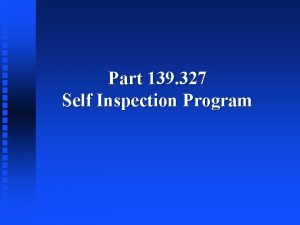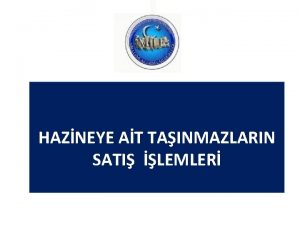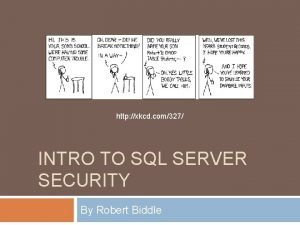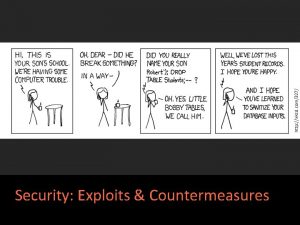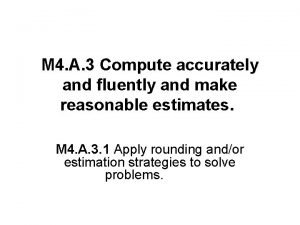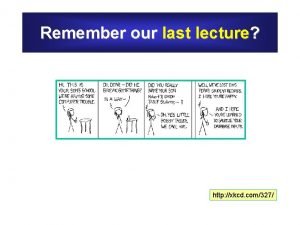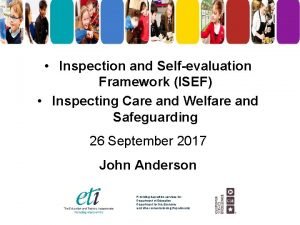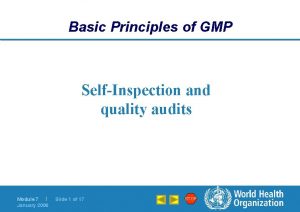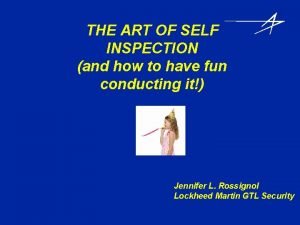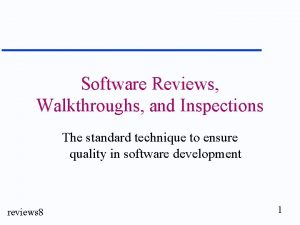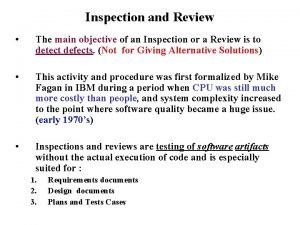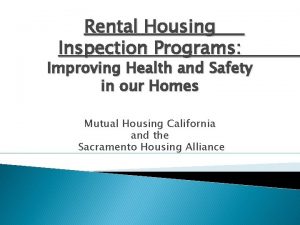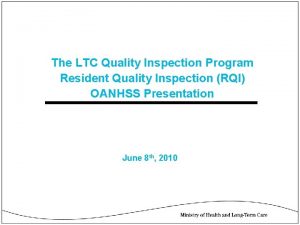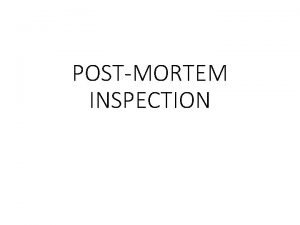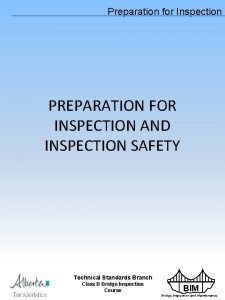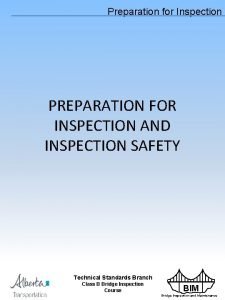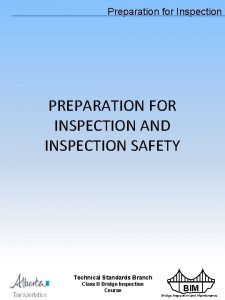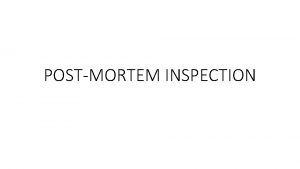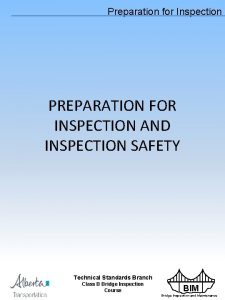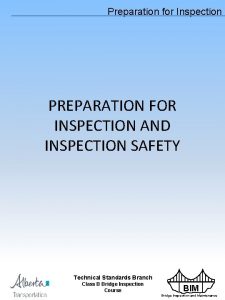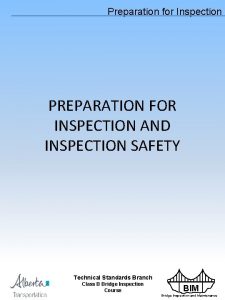Part 139 327 Self Inspection Program TOPICS Review






















- Slides: 22

Part 139. 327 Self Inspection Program

TOPICS Review Section 327 of FAR Part 139 n Elements of a successful inspection program. n FAA inspection results. n Inspection personnel training. n Inspection techniques. n Non-standard marking/lighting/signs. n FAA Navaids. n

139. 327 SELF INSPECTION PROGRAM Self Inspections are required to be conducted: Daily, except as otherwise required by the ACM or ACS. During and after construction activities or weather conditions that may affect safe air carrier operations. Immediately after an accident or incident.

139. 327 SELF INSPECTION PROGRAM Airport Operators must provide: Equipment for use in conducting safety inspections of the airport. Procedures, facilities, and equipment for reliable and rapid dissemination of information between airport personnel and its air carriers.

139. 327 SELF INSPECTION PROGRAM Airport Operators must provide: Procedures to ensure that qualified personnel conduct the inspections. A reporting system to ensure prompt correction of unsafe airport conditions.

139. 327 SELF INSPECTION PROGRAM Airport operators must prepare and keep a record of inspections showing conditions found all corrective actions.

Airport Operator Responsibility Procedures addressed in ACM/ACS. n Airport self inspections are normally conducted twice a day, including a night inspection. n Inspection personnel receive at least on-thejob training. n Checklists are used to document all inspections. n

Airport Operator Responsibility n Elements of a Successful Self Inspection Program u Airport management emphasis u Knowledgeable inspection personnel u Effective inspection techniques u Good documentation u Effective system for corrective actions and follow-up

FAA Inspections n An FAA inspection of the movement area is actually an evaluation of the airport’s self inspection program. n Discrepancies to Part 139 are noted on a Letter of Correction and entered into a national FAA computer database.

FAA Inspections

FAA Inspections FY 94 FY 95 FY 96 FY 97 n FY 98 n Total n Discrepancies 82 84 80 107 97 61% 62% 48% 58% n 63%

Inspection Personnel If airport self inspection personnel are not adequately trained, the certificate holder is not in compliance with part 139. 327(b)(3).

Training Program for Inspection Personnel n Establishing a formal training program consisting of classroom and OJT should reduce the number of part 139 discrepancies noted during FAA inspections and enhance safety for aircraft operations. n Recurrent training may also need to be conducted periodically.

Training Program for Inspection Personnel n Training Topics u Airport Familiarization u Part 139 u ACM/ACS u Marking/Lighting/Sign Standards u Vehicle Procedures & Communications u Inspection Techniques & Records u Reporting Procedures u SMGCS

Problems With Inspection Techniques n Going through the motions. u Daily Inspections are vary routine. n Ineffective inspections of pavement lips and safety areas. u Driving down the runway centerline makes it difficult to observe pavement lips and surface variations in safety areas. n Gradually deteriorating conditions. u Difficult to notice.

Problems With Inspection Techniques n Examples of Gradually Deteriorating Conditions: u Rubber buildup u Faded markings u Faded wind socks u Surface variations due to erosion u Over 3 inch pavement lips due to settling of soil after projects u Turf buildup along pavement edges due to sand u Exposed light stakes due to frost heave

Non-Standard Marking/Lighting/Signage n Since 1991 the area with the most discrepancies has been Section 139. 311, Marking and Lighting.

Non-Standard Marking/Lighting/Signage

Non-Standard Marking/Lighting/Signage n Factors u Specific part 139 requirements for marking and lighting systems went into effect in 1991. u Airports continuously have AIP projects. u High emphasis by FAA on meeting FAA standards, due to past accidents where nonstandard marking/lighting/signage was a contributing factor to the accident.

Non-Standard Marking/Lighting/Signage Airport operators should check project plans and conduct inspections during construction. n Designate an Airport Marking & Lighting Guru. n Unique or non-standard application of FAA standards must be coordinated with FAA & documented in the ACM. n

FAA NAVAIDs n There has been an ongoing problem with FAA NAVAIDs not meeting part 139 requirements. u Bases not maintained at grade level. u Non-frangible installations. u Trenches left during construction. u Equipment shelters located in safety areas.

FAA NAVAIDs n Airport operators should closely monitor FAA NAVAIDs and new installations.
 Airport self inspection
Airport self inspection The ideal self example
The ideal self example Chapter review motion part a vocabulary review answer key
Chapter review motion part a vocabulary review answer key Asteroide 327
Asteroide 327 327 sayılı milli emlak genel tebliği
327 sayılı milli emlak genel tebliği Xkcd sys admin
Xkcd sys admin Inf 327
Inf 327 Xkcd drop table
Xkcd drop table Xkcd vulnerabilities
Xkcd vulnerabilities T***p
T***p 87 rounded to the nearest ten
87 rounded to the nearest ten What is 15 327 rounded to the nearest ten thousand
What is 15 327 rounded to the nearest ten thousand Https://xkcd.com/327/
Https://xkcd.com/327/ Inspection and self evaluation framework
Inspection and self evaluation framework Self inspection gmp
Self inspection gmp Nispom 1-302
Nispom 1-302 Dss inspection
Dss inspection Peer review walkthrough and inspection in software testing
Peer review walkthrough and inspection in software testing Objective of inspection
Objective of inspection City of sacramento rental housing inspection program
City of sacramento rental housing inspection program Abaqis questions
Abaqis questions Usdc seafood inspection program
Usdc seafood inspection program Self image vs self perception
Self image vs self perception
